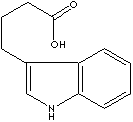PRODUCT IDENTIFICATION

H.S. CODE
TOXICITY
c12c([nH]cc1CCCC(=O)O)cccc2
CLASSIFICATION
Plant Growth Regulator
EXTRA NOTES
A naturally occurring phytohormone auxin (plant growth regulator). Promotes root formation in cuttings, but does not affect ethylene levels.
PHYSICAL AND CHEMICAL PROPERTIES
SOLVENT SOLUBILITY
5
REFRACTIVE INDEX
Stable under ordinary conditions (light and air sensitive)
EXTERNAL LINKS & GENERAL DESCRIPTION
Wikipedia Linking - Indole-3-butyric acid
Google Scholar Search - Indole-3-butyric acid
Drug Information Portal (U.S. National Library of Medicine) - Indole-3-butyric acid
PubChem Compound Summary - Indole-3-butyric acid
KEGG (Kyoto Encyclopedia of Genes and Genomes) - Indole-3-butyric acid
http://www.ebi.ac.uk/ - Indole-3-butyric acid
http://www.ncbi.nlm.nih.gov/ - Indole-3-butyric acid
Local:
Auxin is one of five (or more) major plant hormones (Auxin, Cytokinins,
Gibberellins, Ethylene and Abscisic acid) which affect numerous plant growth
processes functions including cell division and elongation, autumnal loss of
leaves, and the formation of buds, roots, flowers, and fruit. Auxin action is
inhibited by light which is an important role of the growth of stems toward
light (phototropism), against the force of gravity (geotropism) and positively
hydrotropic (moisture-seeking). The cells exposed to light don't grow as quickly
as those on the shaded side, and thus the plant grows toward the light source.
Auxins usually have a ring system with at least one double bond and attached
by a side-chain that terminates in a carboxyl group. Indole acetic acid is the
exact structure of Auxin activity. Parent compounds of auxin action are;
- Auxins
- 4-Chlorophenoxyacetic acid (CAS RN: 122-88-3)
- (2,4-Dichlorophenoxy)acetic acid (CAS RN: 94-75-7)
- 4-(2,4-Dichlorophenoxy)butyric acid (CAS RN: 94-82-6)
- Tris[2-(2,4-Dichlorophenoxy)ethyl] phosphite (CAS RN: 94-84-8)
- 2-(2,4-Dichlorophenoxy)propanoic acid (CAS RN: 120-36-5)
- 2-(2,4,5-trichlorophenoxy)propanoic acid (CAS RN: 93-72-1)
- Indole-3-acetic acid (CAS RN: 87-51-4)
- Indole-3-butyric acid (CAS RN: 133-32-4)
- 1-Naphthaleneacetamide (CAS RN: 86-86-2)
- 1-Naphthaleneacetic acid (CAS RN: 86-87-3)
- 1-Naphthol (CAS RN: 90-15-3)
- Naphthoxy acetic acid (CAS RN: 120-23-0)
- Naphthenic acid, inorganic salts (potassium, sodium)
- (2,4,5-Trichlorophenoxy) Acetic acid (CAS RN: 93-76-5)
- Antiauxins
- Clofibric acid (CAS RN: 882-09-7)
- 2,3,5-Triiodobenzoic acid (CAS RN: 88-82-4)
Cytokinin is a N6-substituted adenines acting as phytohormones such as kinetin, zeatin, 6-isopentenyladenine, benzyl adenine. The principal functions are stimulate cell division in concert with auxin (cytokinesis) and influence the pathway of tissue differentiation (organogenesis). 6-Benzylaminopurine is the first generation synthetic cytokinin which elicits plant growth and development responses setting blossoms and stimulating fruit richness by stimulating cell division. Active cytokinin ingredients include:
- Adenine (CAS RN: 73-24-5)
- Adenine Hemisulfate salt (CAS RN: 321-30-2)
- 6-Benzylaminopurine (CAS RN: 1214-39-7(base), 162714-86-5(HCl)
- N-Benzyl-9-(2-tetrahydropyranyl)adenine (CAS RN: 2312-73-4)
- N-(2-Chloro-4-pyridyl)-N'-phenylurea (CAS RN: 68157-60-8)
- 6-(gamma,gamma-Dimethylallylamino)purine (CAS RN: 2365-40-4)
- 1,3-Diphenylurea (CAS RN: 102-07-8)
- Kinetin (CAS RN: 525-79-1 (base), 177966-68-6 (HCl)
- 1-Phenyl-3-(1,2,3-thiadiazol-5-yl) Urea (CAS RN: 51707-55-2)
- Zeatin (CAS RN: 13114-27-7)
- trans-Zeatin (CAS RN: 1637-39-4 (base), 6025-81-6 (HCl))
- trans-Zeatin riboside (CAS RN: 6025-53-2)
Other Plant Growth Regulators include:
- Abscisic acid (CAS RN: 21293-29-8)
- Ancymidol (CAS RN: 12771-68-5)
- Chlorocholine chloride (CAS RN: 999-81-5)
- Daminozide (CAS RN: 1596-84-5)
- 3,6-Dichloro-o-anisic acid (CAS RN: 1918-00-9)
- Gibberellic acid (CAS RN: 77-06-5)
- Gibberellic acid Potassium salt (CAS RN: 125-67-7)
- Gibberellin A4 (CAS RN: 468-44-0 ) and other gibberellins (more than 110 gibberellins are known)
- Glyphosate (CAS RN: 1071-83-6)
- Jasmonic acid (CAS RN: 3572-66-5)
- 1,3,5-Trihydroxybenzene (CAS RN: 108-73-6)
APPEARANCE
ACTIVE CONTENT
98.0% min
HAZARD OVERVIEW
Toxic by ingestion. Light sensitive. Harmful if swallowed. Causes eye, skin, and respiratory tract irritation. Target Organs: Respiratory system, eyes, skin.
GHS
PICTOGRAMS

HAZARD STATEMENTS
H301-H315-H319-H335
P STATEMENTS
P261-P301 + P310-P305 + P351 + P338
![]()
RISK PHRASES
25-36/37/38
SAFETY PHRASES
26-36-45